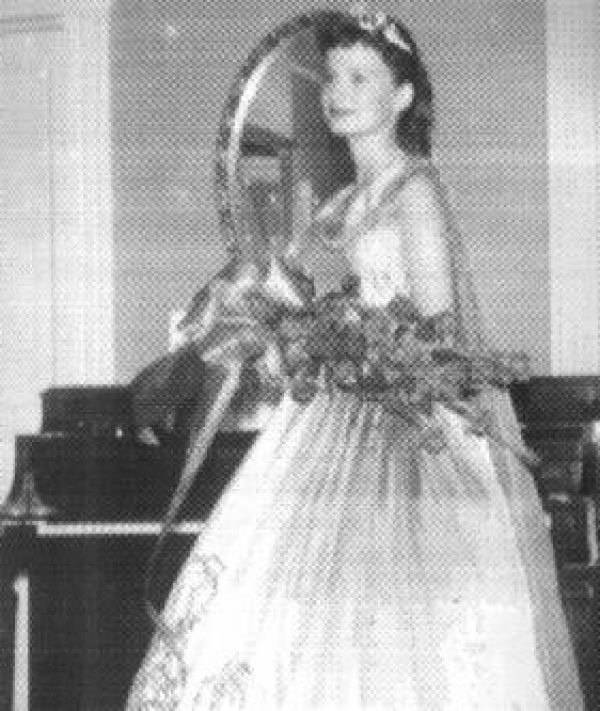Golden Anniversary of Galax, Virginia 1906-1956
August 5-11, 1956
By Frank M. Heaster
Dear Hearts and Gentle People. The name signed at the end of this introduction may fall hard upon the ears of native Galax and Twin Counties folk. For I am not a native, and, in fact, have been a resident for only the past three years.
Yet, it fell my lot to get together a history of Galax for this souvenir booklet for an occasion marking the City’s 50th and Golden Anniversary. Be assured that I claim no credit for the history as it will shortly be presented.
Several people deserve the applause for the work and chiefly among them is a man in his late seventies, Ed Cox, and a teenager, Charles Bolt, a 1956 graduate of Galax High School.
It is almost unbelievable that two persons so apart in age could contribute so much to the history of Galax. Mr. Cox has spent most of his life in the Galax area and he contributes the background for these mementoes.
Charles Bolt, probably more at home on a football field or a basketball court, brings us up to date.
Ed Cox prepared for the Anniversary committee notes on the background of Galax, and Charles Bolt, not thinking of the Jubilee, did his story as an English assignment.
Mr. Cox, who lives in a tidy log cabin on the Baywood Road, knows perhaps more history of the Twin Counties than any other person. His notes for the Jubilee Committee are authentic to the nth degree.
The Bolt youth took his assignment in English seriously, talked to scores of Galax old-timers, read a mountain of clippings, and then wrote his assignment with a deep and sincere sense of responsibility.
Mike Crabill, who was publisher of the Galax Post Herald, was indispensable when it came to doing Galax. His story “Why Is Galax” which appeared in Virginia and the Virginia County in 1950, is not only unique in the manner in which it is written but also is flavorful of his home country.
Mike is a walking encyclopedia of facts about early Galax. Although not a native, he came here early enough to learn to know every mud-hole on Main street and every man by his first name. Mike has been busy for years enjoying Galax and Carroll and Grayson counties. And his enjoyment of his home country permeates this history.
This writer couldn’t stop an introduction without acknowledging the help of Dewey Kegley of Oldtown. Dewey could always be counted on to contribute a picture, a fact, or a story of his beloved Galax.
So it is that folks like Ed Cox, Charles Bolt, Mike Crabill, Munsey Poole, Dewey Kegley, “Date” Day, IL D. Beamer and others too numerous to mention gave this writer inspiration for helping start this 50th Golden Anniversary celebration; and for getting into publishable form, a brief history of Galax.
Boaz Studio was also very helpful in helping us find suitable negatives from which to have pictures made for use in the booklet. Several individuals aided in selection.
So until the 100th anniversary rolls around, I would wish for all Galax, present and past, residents 50 more years of happiness and prosperity and challenge the youngster of today to make the 100th anniversary a mountain compared to the molehill of this celebration of 1956.
What the future of Galax, the nation and the world holds cannot be seen. As Omar Khayyam in the Rubaiyat wrote…. “There was the Door to which I found no Key; There was the Veil through which I might not see.” Perhaps the future is as Pinoro wrote… “only the past again, entered through another gate.”
If that is true surely the year 2006 the 100th year of the city’s life, will find Galax exceedingly more prosperous and, I hope, as friendly, as neighborly, and as warm-hearted as it is in this year, 1956.
Frank M. Heaster
Pioneers, Ghosts, Bonaparte and Galax
By Ed Cox
 One of the earliest settlers of this area was Flower Swift, who settled and built his cabin near the present camp of the Kiwanis Club camp on New River, west of Oldtown, and his land extended up to the present town of Oldtown.
One of the earliest settlers of this area was Flower Swift, who settled and built his cabin near the present camp of the Kiwanis Club camp on New River, west of Oldtown, and his land extended up to the present town of Oldtown.
One of his daughters married Major George Currin, who had migrated from North Carolina and he purchased a tract of land off the Buchanan survey, which included all the land now where the City of Galax is located.
He built his home on the lot where Dr. Virgil Cox’s house now stands and raised his family. One of his daughters married Thompson Roberts, who had come from North Carolina, and they in turn became the owner of the farm of his father-in-law, who also raised a large family at the old home place.
His youngest son, Thomas F. Roberts, owned the home place when the Railway was extended up to its present site and the town of Galax was started.
The country surrounding Galax was settled principally by people of the Quaker faith, a majority of them coming up across the Blue Ridge from North Carolina after the battle of the Alamance in 1771, and the only wagon road across the mountain at that time was the Good Spur Gap road that reached the summit of the mountain at the old Morris Cemetery, near the present Fancy Gap Methodist Church, This road, being the first built, extended north, passing near Good Hope church and on by the present Poor Farm In Carroll County and on north crossing the river at or near Jackson’s Ferry and on connecting with the road leading east to west at Fort Chiswell in Wythe County.
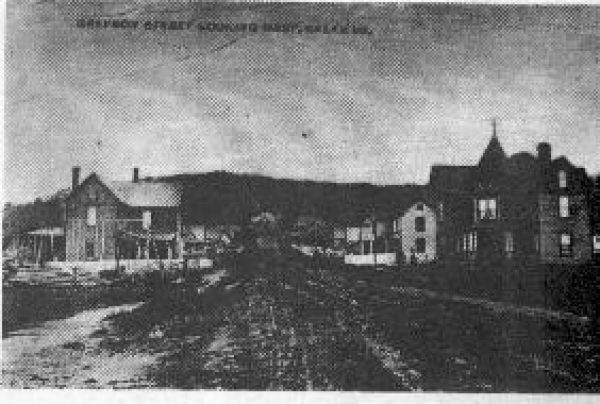
Stage Coaches and Oxen
It was stated that the stage coaches were used over this road when the weather would permit; it is also stated that a couple of yoke of oxen were kept at the foot of the mountain to assist the emigrants up and over the mountain.
A little later a road branched off this road near the Poor Farm and extended west through Grayson county to the Washington county line.
This was perhaps the first through-road built through the county and this road passed through the present city of Galax, crossing the creek near the present bridge on Route 58, following closely the present Stuart Drive, around the town and on out through West Galax, crossing Meadow Creek near Reavistown, on through Baywood, Cox’s ford on New River, over Brush Mountain and on west to Washington county.
After Grayson county was cut off from Wythe county about 1792, other roads crossing the mountain were built, one from Pipers Gap to the County Seat of Grayson which was located at the present town of Oldtown, this road followed closely the present Piper’s Gap Highway and crossed Chestnut Creek near the present Carroll Furniture plant and followed on the creek bank down to the present filtering plant, then crossing the hill passing in front of Brother Anderson’s and the A. C. Painter home and West Galax on to Oldtown.
Also a road was established across the Low Gap and on through the Fairview section to Oldtown.
Earlier than the two last molitioned, a trail led from the mountain across the Coal Creek and Wards Mill Creek valleys and joined up with the road going west at the present Country Club.
Chestnut Yards was so inaccessible to reach by roads that it did not help the surrounding country very much; finally the people induced the N&W to extend their trains up to Blair where it would be more accessible to wagon traffic but the people soon realized that there was not sufficient room there to accommodate the business that had begun to pour in from all directions, whereupon they induced the N & W to extend the line up to the present site of the City of Galax.
J. P. Carico, a native of Stevens Creek community and a trader of horses and mules in the South, was perhaps the most successful promoter of enterprises this section has produced. While staying in Winston-Salem on a trip south with horses, he contacted Colonel Fries, who was a successful textile manufacturer, and induced him to build a mill. After he had helped establish this industry at Fries, and the N & W had agreed to extend their Railway up to the present City of Galax, he, along with J. B. Waugh and perhaps others formed a land company and purchased all the land between the Creek and the present highway on the west side of the creek up to the Anderson property, and proceeded to lay out the town. They secured an engineer from Lynchburg, Mr. DeMot, to whom was given the task of laying out the town which was destined to grow to a city of the second class in a period of fifty years.
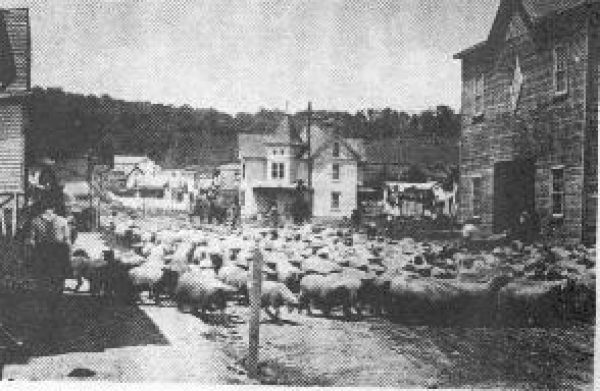
‘Good Ground Goin’ to Waste!’
When the task of laying our the town was finished, a day was set for the opening of lot sales and a large crowd gathered for this opening sale. The most frequent expression heard from the crowd that day was “Why all these wide streets and sidewalks?; the town will never grow to where it needs street cars will be needed; it’s just a waste of good ground.”
When the crowd found that they could buy lots on the main part of town for $100 to $250 for corner lots and could buy lots a couple of blocks back for $50 they shook their heads and said it was entirely too much and many went home with the money in their pockets that they had brought with them for the purchasing lots.
But there are only a few of us left now to see just how wrong we were on that day, to know the prices that are being offered for the crowded condition of these wide streets now with automobiles, a thing that was hid from our thinking at that time.
But business people who saw the advantage of doing business at a point near a railway station began moving in and setting up business; also those who saw the advantage of having in a town where they would have more conveniences also began building homes here.
Among those moving up from Blair were J. B. Waugh & Co., Blair Grocery Co., William (Billy) Dalton, also the Bolens, Kapps, and others. The Ward brothers came in from the Pipers Gap or Wards Mill section, Jim Reavis and R. E. Jones from Reavistown, J. H. Witherow from Oldtown, and many others. Among the business firms that came to the town at the beginning and have continued under the same firm name to the present time are W. K. Early & Son, R. E. Jones & Son, J. C. Matthews & Co., Vass-Kapp Hardware Co., and Bolen Drug Co.
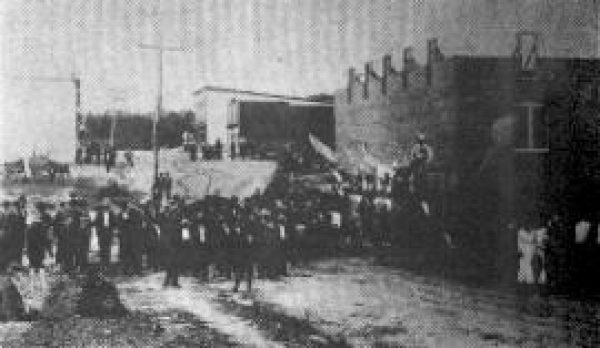
Logs, Crossties, and Tan Bark
At this time the country surrounding Galax contained a large percent of original forests of hardwoods, poplar and pine timber and the marketing of this timber became the main industry of the country around the town; this Industry encouraging the building and grading of better roads, although the roads remained dirt roads for many years.
The farmers in this section used oxen largely for farming and hauling to town, and during this period, Galax could boast of more Ox teams in town any day than any other known town.
J. P. Carico bought the E. P. Givens farm on the east side of the creek and moved there in 1904, and his son James K, Carico, was born there on January 30, 1905, and would be in the running for the first child born in Galax.
This trail was known as the Quaker Trail and the Quakers built a meeting house and laid out a burying ground on a high hill overlooking the Wards Mill Creek. This meeting was first called Mt. Pleasant but was later changed to Chestnut Creek and the burying ground is known as the Old Quaker Graveyard. The land for this meeting house and graveyard was given by Joshua Hanks and William Riddick and the deed was recorded soon after the County of Grayson was established, about 1792.
Joshua Hanks had title to about 1,000 acres of land on both sides of the Mill Creek and built his cabin not far from the meeting house and graveyard. The marker to his grave states that he was born in 1760 and his wife’s name was Ruth. He must have moved to this location soon after his marriage and built his cabin.
“And What of Nancy Hanks?”
Joshua Hanks’ brother whose name was Thomas (as I remember it) was on his way with his family to find a home in the West and came to his brother, Joshua, with his family, and spent considerable time there before deciding to go on farther west; and while he was staying with his brother his daughter gave birth to a girl who was named Nancy. This child went on with the family farther West where they stopped for some time in what is now West Virginia, where she married Thomas Lincoln and became the mother of Abraham Lincoln.
This tradition had been handed down through three generations when it was told to me and I have talked to others Who have passed on now, that had been told the same story.
After checking all the circumstances and dates, I find nothing that would prevent this story from being possible and in all very probably as authentic as any that has been told and written through the years.
Blair’s Forge on Chestnut Creek
About the year 1770, John Blair built a forge just below Blair station on Chestnut Creek for the purpose of smelting and making iron out of the iron ore in that section. The iron bars from this forge were fashioned into shape by the use of a trip hammer; this hammer was powered from a dam built across the creek. After about five years he turned the operation of the forge over to his son, who operated it for many years.
The plateau surrounding the present town consisting of some four or five counties in these early periods was all rural country, with not a single industry to employ the labor outside of the farm, even in most cases to the clothing for the family. The young men who sought to better their circumstances, went where they could find work, and some earned and bought property and settled there.
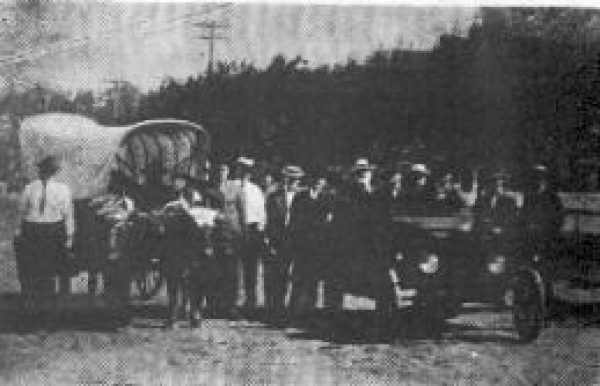
Town Emerges from a Swamp
This rural condition remained until the Railway extended into this community. The N&W Railway had decided to extend the branch line from the main line at Pulaski, Virginia, up New River and Chestnut Creek and on across the mountain to connect with the Railway at Mt. Airy, N.C., so as to give them a more direct route from the coal fields to the South, but they had only succeeded in getting trains running as far as Chestnut Yards when they secured a lease on the line from Roanoke to Winston-Salem that gave them the southern outlet, when they then abandoned the building of this branch line.
Mr. Carico in addition to managing the land company, helped to establish the First National Bank and became its president for a time; he also helped in establishing the Galax Fair Association and was for a long was also Mayor of the town for one or two terms.
J. B. Waugh moved his business and home to Galax and built the home where Mrs. Charles P. Waugh now resides, and his son, Dan B. Waugh, is now in business on the same corner occupied by his father.
R. E. Jones was one of the first comers to Galax and established early the business of H. E. Jones & Son which is now carried on by his son, Walter, and grandson, Walter, Jr. He was also the first Postmaster in Galax and was also one of its first Mayors.
B. F. Calloway, a native of this section, and an attorney, came to make his home in town early and engineered the getting of the first charter for the town and became its first Mayor. He had charge of the land company for some time but finally moved to Salem, Virginia, where he resides at this time and is nearing his ninetieth birthday.
Much of the land where the town now is at its beginning was grown up in bushes along the branches and wet places in the lower bottom, and one particular place known as the bog or sink hole where no bottom could be found, was located near the W. K. Early & Son lumber yard and the Esso bulk stations. There have been many tales spun about this particular spot but the oldest one known was “That a boy was plowing near this spot when his horse or mule became frightened and bolted, running into this bog and sank out of sight, plow and all, and was never seen afterward.”
It is well authenticated by older people that this bog could not be successfully navigated without carefully hopping from one tussock or stool to another and that a fence rail could be pushed down out of sight end-wise with the hands, the black watery muck was so fluid.
When the Railway was constructed to its present site, a canal was cut from this bog to the creek that lowered the water so that buildings are being erected on the place where this treacherous bog once existed.
It was believed by the people interested in laying out the town that the business street would be what is now known as Center Street, so it was called Main Street and the street running north and south that is now Main Street was named Mt. Airy Street The names were changed and the street named Main in the beginning was changed to Center Street, and the Street name Mt. Airy was changed to Main Street as it is today.
The town was first called Bonaparte but the name did not seem to ring just right and it was seen that it would not be popular, so the name of Galax was decided on as this is the name given to an evergreen, that grows along the Blue Ridge adjacent to the town and is gathered and shipped to all parts of the country.
About Ghosts and Murderers.
Other old stories told about happenings near the present town of Galax are interesting.
This one concerns a haunted turn in the Old Pipers Gap Turnpike near where the road crosses the creek near the Carroll Furniture Company.
Near this turn in the road is a graveyard and this graveyard seemed to be the favorite staying place for this haunt which appeared in the form of a small dog that would wait for a lone rider that might have to pass that during the late hours of the night and proceed to jump on the horse behind the rider and accompany him to a point near the ford of the creek when it would leap off and disappear as mysteriously as it had appeared.
In the hill just east of the Carroll Furniture Company plant is a hollow where in the early days a farlily of Negroes lived, and in this cabin a Negro man was murdered, and as might be expected this locality became haunted. Travelers who had to pass along the road near this point late in the night, could see a bright light moving around in this hollow and a little bell would start tingling and follow them until they were well out of the vicinity of this tragedy. There were men in the community beyond this point who were allergic to haunts that could not be induced to go to Oldtown for a doctor at night because of having to pass this place.
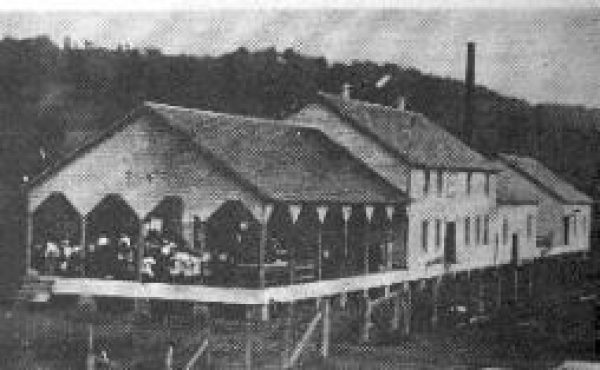
Far and Few Between
At the time the town was being laid out there were no more than three dwellings in sight of the place on the west side of the creek and only two that I can think of on the east side of the creek.
The land purchased by the land company contained no roads or houses and there was nothing in the way to obstruct the laying out of the town, which accounts for its orderly appearance at the present time.
Until the laying out of the town of Galax, Oldtown had been the center of the surrounding country, from the time the county was cut off from the county of Wythe, about 1792, and all roads led to Oldtown.
About the First Courthouse
The land for the site of the first court house of Grayson County was furnished by Flower Swift and Clark Nuckolls. There were two courthouses built for the county. The last one is still standing and after the courthouse was moved to Independence, the building was occupied by William Waugh and used as a home and hotel. The little brick building across the street on the corner was built and used as the clerk’s office but just when this building was erected I do not know but it must be one of the oldest buildings standing in the county. After the court was moved to Independence this building has been used for the post office, until just recently when it was discontinued.
This early county seat, like all others of its kind, was the scene of much happiness and also many tragedies, most of which have been forgotten by this present generation, but to try to relate any of them ‘would not fit into this story.
The jail at this first courthouse was bull out of hewn logs. These logs were oak and they were so large that the hewn sides were 18 inches in width. The building was two stories and the partitions between the cells were of hewn logs also. The cells were small with high ceilings and for added protection the inside of the walls were driven thick with shop nails with high round heads that were driven so close to each other that they nearly touched.
I never heard of anyone ever cutting his way out of this jail.
This Is Charles Bolt’s Galax
Blue Mountains and Green Meadows
Galax is a mountain town-the Appalachian trail runs down Main Street-and yet it is located in what is actually a high (2,500 feet) valley-like plateau which runs south all the way from the Potomac deep into North Carolina.
It is gentle country, marked by rolling swells of grassy hills and by neat, extremely well-kept farms- Along the eastern edges, where the country tilts upwards to form a great ridge and then plunges steeply down to the floor of the Piedmont, it is a ruggedly beautiful country.
The Blue Ridge Parkway threads down that crest. The Parkway, only seven miles from Galax, marks the dividing line between the rocky, wooded mountain shoulder and the softer grass- lands of the magnificent mountain valley.
The local people are justly proud of the friendly, progressive city of Galax which nestles in this picturesque setting. To those unfamiliar with this section, it may seem far from civilization, but to those who live here and love it, Galax is the center of the universe.
A Green Leaf Becomes the Name of a City…
It’s not exactly easy pickings, and one won’t make a fortune at it. It takes some mountain climbing, too. But one can work in the shade, and quit when he gets ready.
So a lot of mountain families still “galack” for their groceries along the southern crest of the Blue Ridge Mountains. When they turn the children and the old folks loose at it, too, the shiny leaf of the galax plant pays a fair share of their sustenance. For picking the galax leaf is a Southern Appalachian monopoly, and the florist trade still offers a ready market for the wavy-edged, heart-shaped leaves. So the enterprise which gave Galax its name fifty years ago still sends Virginians and North Carolinians out over the slopes with tow sacks trailing when the season is right.
Cities like Boston, Chicago, Philadelphia, and New York take them by the thousands, and many others find their way into the florist markets throughout the world.
The galax leaf thrives in cool, moist soil in the shade, where the root of the herb sends up five or six leaves, each appearing separately above the ground on its own long stem. In summer the leaves are bright green, and in winter they turn a golden bronze. The leaves can be picked any time of year except from about mid-March through May.
Galax grows best in a seventy-five mile stretch from Galax roughly to Spruce Pine, North Carolina, according to T. N. Woodruff, Low Gap, a merchant and farmer, who started his present business of shipping galax leaves In 1907. Every city in the United States and Canada large enough to have a florist has done business with the firm of W. M. Woodruff’s Son and Company.
“Galacking” is only an incidental business now to fast growing Galax. But the folks keep a sentimental interest in the expeditions that gave Galax its name. The younger ones probably don’t even know the place was first called “Bonaparte” when one or two houses appeared before 1905; and even the old ones don’t know why. But the title lasted only a few months, according to City Manager W. G. Andrews.
It changed, he says, after an official of the Norfolk and Western Railway, J. W. Cook, saw a wagon load of galax leaves sitting on the tracks In town.
“Why don’t they call the place Galax?” he said.
And so it was.
In 1920, There Was One Sidewalk…
Galax may well be said to have its actual beginning insofar as any particular date is concerned, on Deoember 17, 1905, when the first lot sale was held. Because of the railroad being extended, December 3, 1903, people began to move here from Blair and Carroll and Grayson Counties.
Among the most prominent in the activities, that resulted in the founding of Galax, and the busy, growing second class city that we know today, were the late former mayor, J. P. Carico, the late former mayor, R. E. Jones, the late Senator T. L. Felts and the late Captain John B. Waugh. Others were instrumental in the beginning of Galax, but these four may be considered as having been the most active.
The first house in Galax was built by Billy Galilinore. The house is located on the corner of North Main and Virginia Streets. It is now the residence of Dr. and Mrs. Paul H. Kapp and has been occupied by the Kapp family since 1905.
The late Dr. J. W. Bolen was the first to move his business here from elsewhere. He moved his office, or little drug store, from Blair without tearing it down. It took three yoke of oxen to move his office. Three days were required to move it because the roads had to be widened and holes had to be filled.
Good Government Brought Progress to Galax..
When Galax was incorporated in 1906, there was a Mayor and Council Government. Under this government the clerk and treasurer were appointed.
Ben F. Calloway was mayor when the first Town Charter was issued.
The first council was: Elbert F. Wright, carpenter and builder, Dr. J. K. Caldwell, E. C. Williams, a jeweler, M. L Bishop, livery stable proprietor, J. H. Kapp, hardware merchant, and Dr. J. W. Bolen, physician and druggist.
Ex-Mayor Ben F. Calloway, about eighty-seven, now lives at Salem, Virginia. He remembers that Galax quickly became a busy shipping point for cross ties, acid wood, livestock and poultry, and tan bark after some of the leading citizens persuaded the Norfolk and Western Railway to extend its line.
Calloway, first a lawyer and then a minister, is the only surviving stockholder of the land development company which gave Galax its start. He assisted in drawing up the town’s charter and went to Richmond to help get the General Assembly to approve it.
Calloway carried on his law practice in addition to his municipal duties. He had had a “reasonably good practice,” handling both criminal and civil cases in the wide territory around Galax.
The mayors following Calloway in succession were: J. W. Stamey (1908), J. F. Vass (1909), R. E- Jones (1911), J. F. Vass (1912), D. A. Robertson (1915), J. F. Vass (1916), D. A. Robetson (1920), DaCosta Woltz (1930), J. P. Carico (1932), B. D. Beamer (1934), W. G. Andrews (1941), R. L. Nelson (1942), Ross P. Penry (1946), Dr. R. C. Bowie (1950), B, D. Beamer (1952), and Dan B. Waugh (1954).
In 1922 the town charter was amended to adopt the Town Manager form of Government and I. G. Vass, who had acted as Clerk of the Town, was made the first Town Manager. There have been only four Town Managers in Galax during its history. They are: I. G. Vass, H. M. Todd, Orrin Rhudy, and W. G. Andrews. The manager acted as clerk to the council as well as Commissioner of Revenue. He had complete charge of the business of the city under the supervision of the city council.
The new charter went into effect September 1, 1954. After the extension of the corporate limits the population was 5,237, which classed Galax as a second class city under the Virginia law. This gives the city its own government independent from the county government.
Additional councilmen were elected in June, 1955, the first election as a second class city. Councilman Dan Waugh was chosen by the councilmen to act as Mayor and has no power other than presiding over the council, although he does have a voting privilege on the council.
The school system was also changed when Galax became a second class city. Three people (men or women) are appointed by the town council and have control of all the operations of the schools. The school board, Mrs. Don Dickenson, Mr. O. L. Parsons, and Mr. Duane Ward, appoints the Superintendent of the City Schools. This person may be a high school principal. L. W. Hillman is the present Superintendent of Schools and Principal of Galax High School. Bryan Collins is principal of the Grade School.
‘In Youth We Learn”… Galax and Its Schools…
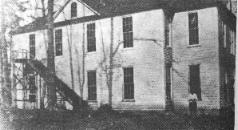
When Galax was laid off, the promoters set aside about ten acres of a beautiful pine grove or public school purposes. Within two years money was raised through box suppers, home-talent shows, and private subscriptions to build an elementary and high school building. It was wooden structure with four classrooms on the first floor and an auditorium on the second, all of which were heated by wood-burning stoves. This building was replaced in 1925 by the present auditorium and classrooms. G. F Carr was the first principal of the school. He held this position for seven years before he became superintendent of schools in Grayson County.
By 1908, Galax had a population of six hundred and very inadequate school facilities. A new brick building was begun, consisting of eight classrooms, a music room, and an office. This building was used until 1936 when it was burned, being replaced the following year by the present modern building used now for the lower grades.
In 1955 a separate high school building was constructed and equipped at a cost of more than three hundred thousand dollars. This building is presently occupied by high school students who enjoy the new equipment, the cleanliness and cheerfulness of the walls and matching tile floors, adequate sanitary drinking fountains, and a modern heating and ventilating system. When the auditorium, gymnasium, cafeteria, laboratory, and stadium have been completed, Galax can well boast of the progress it has made toward giving its children the proper facilities to become outstanding young men and women.
Students were given the opportunity to study music, expression, and are from the beginning. however, in recent years these subjects have not been a part of the school itself.
Here is a complete list of the principals of Galax High School in succession: G. F. Carr, S. W. Brown, Ned Hunger, S, G. Wright, J. A. Livesay, B. M. Cox, Miss Jessie Bruce (now Mrs.Lee Beamer), W. J. B. Truitt, Heath A. Melton, Stanley T. Godbey, Wythe F. Wampler, Roy Kyle, Fred Wygal, Paul Cox, and Lesile W. Hillman.
Along with Virginia as a whole, Galax shares in a difficult school problem, but far-sighted and efficient leadership, supported by an intelligent citizenry, will solve this problem, just as other perplexing situations have been solved in the community and section.
Wheels and Machines Caused a Village to Become a City
Galax has been fortunate in escaping the inherent weaknesses of absentee ownership. With the exception of the Carnation Company’s milk condensing plant and the Burlington Mills weaving plant, all of the city’s industries are home owned.
With the same two exceptions, the Galax industries began modestly-most of them on a borrowed shoestring and grew with the town.
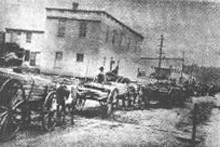
B. C. Vaughan may well be considered the father of the furniture industry in Galax, with the Vaughan-Bassett Industry as the parent organization. Mr. Vaughan and J. D. Bassett, organizer of the largest furniture industries in the world, met with a group of citizens in the old Masonic Hall over Vass-Kapp Hardware Company and formulated plans for what proved to be the first successful industry in Galax. Later Mr. Vaughan was joined by his brother, T. G. Vaughan, when he was released from the armed forces after the first World War. In 1925, T. G. Vaughan organized his own factory, the Vaughan Furniture Company, largely owned by local capital. which is presently operated by his sons, George and John Vaughan.
The Vaughan Furniture Company, Incorporated, manufactures a popular line of medium-priced bedroom, dining room, and dinette suites, which are sold all over the United States. Its large and substantial plant is equipped with the most modern machinery, and the working conditions in this factory are the very best. This plant has recently increased its facilities about one third.
The Vaughan-Bassett Furniture Company, established in 1919, was the pioneer and also the largest plant of the Galax furniture industry. It burned February 27, 1951, but was rebuilt in 1952.
John Messer came to Galax in 1927 with little except a gleam in his eye for assets. The Mirror plant which he started in a shed a quarter of a century ago has silvered more mirrors than my other plant in the United States.
On top of that, John Messer has since added a second mirror plant (located in Mount Airy), and three furniture factories (all in Galax) to his string of investments.
The Galax Mirror Company was founded in 1927, and is the parent company of the Messer Industries, one of the great furniture manufacturing enterprises of the south. The mirror plant serves furniture manufacturers in the southern states and produces a popular line of mirrors which is sold in every state in the Union. J. A. Messer, Jr., is president of the plant.
The Webb Furniture Company is one of the major industries of the thriving Industrial center of Galax. It manufactures a well known and popular line of medium priced bedroom furniture, which is sold in every state in the Union. The company is important to Galax by providing one of its largest payrolls, in addition to the purchase of several million feet of local lumber annually. It was founded in 1925 and is a unit of the Messer Industries.
The Galax Furniture Company, Inc., was founded in 1925 with C. L. Smith as its owner. In October of 1943, the company was purchased by John A. Messer, Sr., becoming, with the purchase, a unit in the Messer Industries group of factories. With this change of ownership, the plant has been thoroughly modernized in every respect and has enjoyed an increase in production each year thereafter. The company has enjoyed over these years a fine reputation for manufacturing a better grade of popular priced upholstered furniture.
The fifth division to be added to the Messer Industries was the Carroll Furniture Company. It began operations in 1946 and manufactures a quality grade of bedroom furniture, sold in the National Market, with some going to export.
In January, 1955, the Webb Furniture Company and the Carroll Furniture Company were consolidated under the name of the Webb Furniture Corporation.
Probably no other factor has contributed as much to the improvement of economic conditions of the farmers of Grayson and Carroll, and adjacent counties of this area, as the Carnation Company since it was established at Galax in May, 1937. Farmers in the Galax area, realizing that they have a dependable market for all the milk they can produce, have made much progress toward becoming better established in dairying.
The Galax Weaving Plant, a unit of Burlington Mills Corporation, is a modern, efficient textile plant affording employment opportunities for hundreds of Galax, and Carroll and Grayson county people. Several additions to the original plant, erected in 1936, have been necessary. Each addition has brought an increase in the number of employees, making it one of the most modern, scientifically equipped plants for the production of drapery, upholstery, cloth and slip covers in the United States. The company endeavors to provide steady employment, fair wages, excellent working conditions, and a number of employee benefits to its people.
Harris-Marshall Hosiery Mills, Inc., which began operations in 1945, is another prosperous industry of Galax. The plant of the company is modern in every detail, with equipment representing the latest development in machinery designed for efficient and economical production of men’s hosiery. Working conditions In the plant are ideal. H. L Harris, president, treasurer and manager, has over twenty-five years experience in the manufacture of hosiery.
Sawyers Furniture Company manufactures living room furniture. Their product has been distributed in many states throughout the United States with excellent acceptance. It was established in 1945 by C. F. Sawyer and expanded in 1950.
The Penry Manufacturing Company, organized in 1944 under the name of the Old Dominion, expanded in 1950. Ross P. Penry, president and general manager, is well known to the textile industries of the South. Mr. Penry whose Christian attitude has meant much to the Galax community, offers prayer every morning with tis employees. The company manufactures polo, “T” and sport shirts.
Galax continues to grow Industrially. In 1954, the Wonderknit Corporation located in the old Galax Weaving plant. Today, the company is one of the City’s top employers, manufacturing shirts of every description that go throughout the nation for sale. Wonderknit has become an important cog in the economy of Galax.
The R and H Hosiery Co. was formed only months ago and now occupies a site on Oldtown street adding Immensely to the industrial picture of Galax.
The famous brand name “Hanes” is now part of Galax. Early in 1955 the Hanes company (headquarters, Winston Salem, N. C.) began the local manufacture of many items in the Eades Building on South Main. This year the Hanes firm has opened a second plant on West Grayson street. Hanes definitely has come to Galax.
As this book goes to press, two other industries have definite plans for locating plans in Galax.
The Churches of Galax ……. From Whence Comes Our Strength
The history of a city’s churches indicates well the trends of that city’s development toward a well-rounded life for its citizens. The moral and spiritual growth of its people are of even greater importance than Its physical and mental growth.
Galax points with pride to the zealous growth and expansion of its churches. This nation, under God, was founded upon religious principles of love for God and respect for the rights of one’s fellow man; hence, our city gratefully acknowledges this dependence upon God’s merciful care and leadership. It is these principles of religious piety and love of country over which patriotically Old Glory protectingly flutters in the breeze.
Major denominations represented by the churches of Galax are the Christian (Disciples of Christ), Baptist, Methodist, Presbyterian, Friends (Quakers), Brethren, and Protestant Episcopal. handsome edifices of worship are maintained by all of these organizations.
The history of Methodism in Galax is practically synonymous with that of the city itself, the first Methodist Church having been erected on West Center Street where the present large and commodious First Methodist Church now stands. The congregation moved here from near by Oldtown soon after the beginning of Galax as a town. The present church edifice was erected principally in 1926. Various improvements have been wrought from time to time since, including acquisition of a handsome and modernly convenient parsonage.
Also early in the history of the city came to Galax the Baptists as a group. Their first church home was established on West Oldtown Street. Later, in the 20’s, the neat and vastly modern structure that is now the First Baptist Church on North Main Street was constructed. Great improvement has been made since, in the way of additions to the church plant, and otherwise.
In the days of Galax the Presbyterians maintained their church home at Oldtown, where they were housed in a handsome frame building. Later, as an outgrowth of this beginning, the present brick structure on West Center Street that is now the First Presbyterian Church was erected. In this congregation also came the need for expansion as the years passed, and suitable additions were made.
Many years ago also the Disciples of Christ organized here and constructed a frame building on Washington Street, near North Main. In due time this congregation too felt the need for more room, and the need, transferred into constructive action, took the form of the magnificent structure that is now the First Christian Church, pointing its tall spire heavenward from a commanding eminence that overlooks a large portion of the city, from its site on West Stuart Drive. This is Galax’s newest downtown church building among those of the major beliefs.
The Friends (Quakers) purchased the former Baptist building on West Oldtown Street when the Baptists moved to their new location. The Friends have added many improvements through the years, and now form an active, if small, church organization. The Friends Church building is the oldest house of divine worship in the city.
One of the newer churches in the city is the handsome stone structure that houses the congregation of the First Church of the Brethren on Givens Street. Here an active and dynamic church program is promoted by a zealous band of believers. The building was erected through a program of donated labor in a concerted “spare time” effort.
In recent years the Pentecostal Holiness denomination has erected a church on an eminence of ground in the western heights overlooking the city. There, also an active program of religious promotion is being carried forward.
St. Andrew’s Episcopal Church is the city’s latest addition among its church organizations. Only In recent months has this small, but determined, flock reached a status whereby it can have the services of a full-time rector. This church is housed in what was formerly the Presbyterian Church at Oldtown, but is definitely a part of the larger Galax area. An improvement project has been carried forward.
A Primitive Baptist Church has also been a part of the church life of the city for many years. This church building stands on MacArthur Street.
